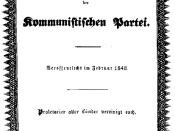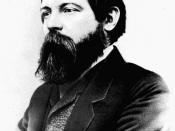The Manifesto attempts to explain the goals of Communism, as well as the theory underlying its movement. It argues that class struggles, or the exploitation of one class by another, are the motivating force behind all historical developments.
The Manifesto talks about how Modern Industrial society is characterized by class conflict between the bourgeoisie and proletariat. The bourgeoisie are the Capitalists, the employers of wage laborers, and the owners of the means of production. The Proletariat are the laborers they have no means of labor and are therefore slaves to the bourgeoisie. The force of capitalism says Marx will lead this relationship to cease to exist. Thus, the proletariat will lead a revolution. However, this revolution will be of a different character than all previous ones: previous revolutions simply reallocated property in favor of the new ruling class. However, by the nature of their class, the members of the proletariat have no way of appropriating property.
Therefore, when they obtain control they will have to destroy all ownership of private property, and classes themselves will disappear.
Marx argues that this development is inevitable, and thus capitalism is unstable. Therefore, the Communists intend to push society toward its natural destination. They argue that the elimination of social classes cannot come about through reforms or changes in government. Rather, a revolution will be required.
The Communist Manifesto was written during mid-19th Germany. It was written during the Industrial Revolution, where rapid wealth came to the factory owners and the workers became increasingly impoverished. Marx saw this as a grave injustice and he wanted to right that wrong. I thought this book was very interesting. The way Marx wrote I thought was very good. I especially liked when he wrote: ''A specter is haunting Europe -- the specter of Communism." This book...


